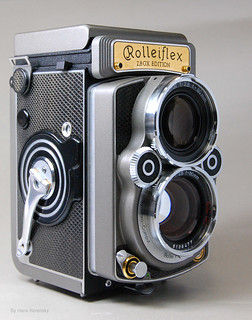Rolleiflex 2.8 GX

|
| Rolleiflex 2.8 GX image by Japancamerahunter (Image rights) |
The Rolleiflex 2.8 GX is a medium format TLR camera manufactured by Rollei Fototechnic GmbH.
Contents
General
After the bankruptcy of Rollei in 1981, its successor, Rollei Fototechnic GmbH, produced some special versions of the Rolleiflex 2.8 F. These were so succesfull that the management decided to bring out a new Rolleiflex named the GX.
To simplify production the automatic film start sense mechanism as used on the F was abandoned and instead the way of the Rolleicord was used, a start marker alongside the film gate.
They decided however to incorporate a new lightmeter design of the type, with Silicon photo diodes behind semi-transparent parts of the mirror, which was successfully used before on several Rollei SLR's.
There were 2 models manufactured :
- Model 1 from 1987 to 1994
- Model 2 from 1995 to 2000, only in special editions.
Model 1 Specifications
- Format : 12 exposures of 6 x 6 cm on 120 type rollfilm.
- Taking lens: Carl Zeiss Planar 1:2.8 f=80mm, HFT Coating, made by Rollei.
- Viewing lens: Heidosmat 1:2.8 f=80mm.
- Filter Bayonet : Both lenses, size 3.
- Parallax error correction.
- Shutter: Synchro-Compur X CR0 leaf shutter. Speeds 1 to 1/500 sec. and B.
- Flash synchronisation : Accessory shoe with system contacts. X-sync socket.
On film flash measurement with a single Si photo element. - Lighmeter system : Coupled, centre-weighted average metering by two Si photo elements
behind the finder mirror, Five-LED display in viewfinder. 25 to 6400 ASA - Color Lacquer : Black
- Color Leatherette : Black
- Dimensions WxDxH: 109 x 108 x 147 mm
- Weight: 1235 grams
Model 1 Special Editions
A great deal of the success of the TLR's produced by Rollei Fototechnic GmbH was due to their special editions which were aimed at the collectors market.
Special edition 60 Years Rolleiflex

|
| Rolleiflex 2.8 GX, "60 Years Rolleiflex" edition image by Hans Kerensky (Image rights) |
- Production : 1989, 1500 units
- Some external metal parts gold plated
- Lacquer : Medium grey and black
- Leatherette : Black and Grey, reptile leather motif
Special edition Helmut Newton
- Production : 1994, 500 units
- Lacquer : Black
- Leatherette : Grey
Special edition Expression 94
- Production : 1994, 500 units
- Lacquer : Black
- Leatherette : Suede, Anthracite
Special edition Gold Expression 94
- Production : 1994, 33 units
- External metal parts 24-karat gold plated
- Lacquer : Black
- Leatherette : Brown
Special edition Japan
- Production : 1995, 130 units
- First GX with a Seiko leaf shutter, Seiko Nr.0
- External metal parts gold plated
- Lacquer : Blue Urushi
- Leatherette : Dark brown, reptile leather motif
Because of the Seiko shutter this special edition of the GX can be considered as a transition between model 1 and 2.
Model 2 Specifications
Only differences with Model 1 shown.
- Shutter: Seiko Nr.0 leaf shutter. Speeds 1 to 1/500 sec. and B. (Except first part of the "75 years Rollei" edition)
- Improved design of the Focus Knob which now hides the battery compartment cover
- Different design of neck strap attachment
Model 2 Special Editions
All "GX Model 2" cameras were delivered in special editions which were aimed at the collectors market.
Special edition 75 years Rollei
- Production : 1995, 900 units
- Many external metal parts gold plated
- Lacquer : Black
- Leatherette : Brown, reptile leather motif
First part of this edition still equiped with a Synchro-Compur X CR0 leaf shutter.
Special edition Expression
- Production : 1995 to 1996, 1000 units
- Lacquer : Black
- Leatherette : Matt black, extra grip
Special edition Club Rollei Jersey
- Production : 1996, 100 units
- Lacquer : Black
- Leatherette : Bordeaux red, reptile leather motif
Special edition Rolleiflex 2,8 Royal
- Production : 1996 to 2000, 1000 units
- Some external metal parts gold plated
- Lacquer : Blue Urushi
- Leatherette : Brown, reptile leather motif
Bibliography
- Claus Prochnow, Rollei Report 4, first edition, Braunschweig, Lindemanns Verlag, 1997, ISBN 3-89506-170-0.